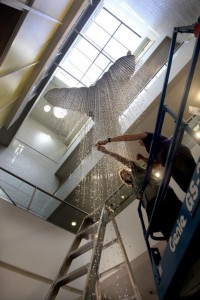By MARY ABBE www.startribune.com
Winners of the 2010/2011 McKnight Visual Artist Fellowships take deadlines seriously. Given $25,000 each and a year in which to incubate their new projects, the four grant winners kept spinning their creative wheels until minutes before last Friday’s opening reception for their show at Minneapolis College of Art and Design.

As the first patrons came through the door, McKnight winner Andréa Stanislav and several assistants, perched on power lifts, were still untangling a cascade of filaments studded with rhinestones. Suspended from the ceiling of an atrium, the shimmering cascade is intended to be a poetic evocation of the Burj Khalifa, the world’s tallest building, in Dubai. Since 18 minutes remained before the show’s official 6 p.m. opening, there was still time — theoretically, at least — to remove the lifts and install a pile of mirrored rocks designed to suggest the elaborate reflecting pools that surround the Burj in its desert homeland.
To be fair, the other three winners — Matthew Bakkom, Cameron Keith Gainer and Aaron Spangler — topped off their installations earlier in the afternoon and aren’t responsible for the last-minute chaos. Their work is so opaque, however, that perhaps it would have benefited from some last-minute tweaking.
Even by the standards of contemporary art, where obscurity is often confused with genius, this is an unusually hermetic show. Little, if any, genius animates these endeavors. There does appear to be a good deal of earnest effort buttressing sincere attempts to communicate whatever opaque notions the artists are nursing. They obviously spent a lot of time putting things together. But with the exception of Stanislav — whose installation is both accessible and intellectually yeasty — this exhibition is a real head-scratcher.
Andréa Stanislav
Stanislav’s installation references her glamorous earlier work while documenting aspects of an exotic desert city whose staggering wealth and fantasy architecture dazzle the mind. Previously, she metaphorically explored the American notion of Manifest Destiny, i.e. the national obsession with riches, power and endless opportunity, through installations featuring, for example, videos of exploding missiles coupled with mirrored horses and Las Vegas glitz. Her new focus on Dubai extends those themes into fresh political territory. Flanking her rhinestoned and mirrored tribute to the Burj are two videos she made during recent trips to Dubai. One documents an astonishing skyscraper city, a watery Venetian mirage in the desert, that was built in “Half a Generation,” as she titles the installation. The other is a sketchy account of the squalid immigrant labor camps that house the workers who build and maintain the city.
Stanislav tips her own political hand by punctuating her videos with spray-painted phrases such as “Cine-Marx,” “FreuDemocracy.” Obviously intended as a commentary on economic, environmental and human exploitation, her videos and installation are fascinating accounts of a world that, however real, almost defies comprehension.
Cameron Keith Gainer
Best known locally as the sculptor of “Minnie,” a playful metal monster that lurks in Minneapolis lakes during the summer, Gainer used his grant to try his hand at filmmaking. What might be dubbed his “plot” reads like a shaggy dog story. Intrigued by bioluminescence, he found a bay full of endangered bioluminescent organisms near an island off the coast of Puerto Rico. Then he hired a swimmer to agitate the water in lyrical patterns while he filmed her movements and the light they triggered. The result is a moody 18-minute film that suggests fading fireworks or distant galaxies exploding in deep space. Called “Luna del Mar,” after the swimmer, it has a spacey soundtrack by Alex Waterman and the overall feel of a self-consciously arty vacation flick.
Matthew Bakkom and Aaron Spangler
Bakkom and Spangler are more conventional, though no less ambitious. A language lover, Bakkom fashioned a crisp, billboard-sized, graphic design featuring two neatly stacked words: “Hustling,” atop “Sunlight.” Rearrange the letters and you see the anagram. He also offers an inky seascape, all brooding sky and rumbling waves. While Barbara Kruger and Ed Ruscha, among others, have made rich careers out of visual wordplay, Bakkom’s entry into the field is, as yet, too minimal to parse.
Spangler’s aspirations are also big and pointlessly mystifying. He apparently carves bas reliefs in wood, places them under huge sheets of raw linen, and transfers designs from the carvings onto the linen buy rubbing crayons over the fabric. Roughly 10 feet tall and 18 feet wide, his featured piece may read as a shadowy sci-fi apocalypse with body parts (arms, legs) rolled over by tractor treads, monster towers or undulating seas. Or maybe it’s just a big faded linen shroud. Either way, his labored images come across as wan and jumbled.












